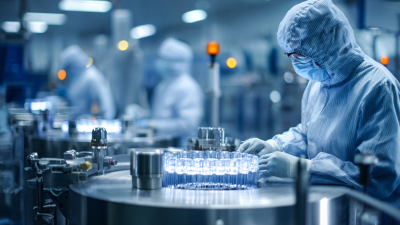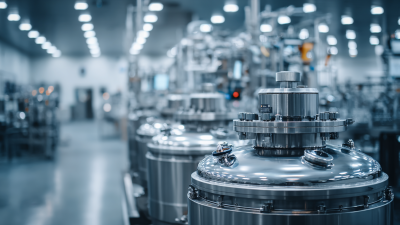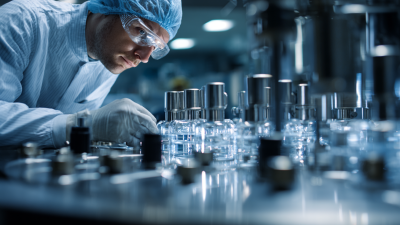Exploring Innovations in Pharmaceutical Production for a Sustainable Future
The pharmaceutical production industry is undergoing a transformative evolution, driven by the urgent need for sustainability and efficiency in drug manufacturing practices. According to a recent report by the International Pharmaceutical Federation (FIP), the global pharmaceutical market is projected to reach $1.5 trillion by 2023, underscoring the industry's rapid growth and the concomitant environmental challenges it faces. As pharmaceutical companies seek innovative approaches, it becomes crucial to implement sustainable production methods that minimize waste and conserve resources.

As we explore the innovations shaping the future of pharmaceutical production, it is essential to consider how emerging technologies like green chemistry, biomanufacturing, and digitalization can dramatically reduce the environmental footprint of drug manufacturing. By harnessing these advancements, the pharmaceutical industry has the potential to pave the way for a sustainable future while continuing to meet the healthcare needs of a growing global population.
Advancements in Biomanufacturing for Eco-friendly Drug Production
Advancements in biomanufacturing are transforming the pharmaceutical industry towards a more sustainable future. Recent breakthroughs in biotechnology and artificial intelligence are creating pathways for eco-friendly drug production processes. For instance, the University of California, Davis, is leveraging a substantial National Science Foundation grant to innovate plant biomanufacturing techniques that promise to be both cheaper and more sustainable, addressing the growing demand for efficient drug production. These initiatives reflect a larger shift within the industry towards sustainable practices that can effectively meet the needs of both patients and the planet.
Moreover, one-carbon (C1) biomanufacturing is emerging as a game-changer in the quest to replace fossil-derived feedstocks, thereby promoting circular carbon economies. This technology not only reduces environmental impact but also supports the development of sustainable pharmaceuticals, such as drugs and biologics. Across the Asia Pacific region, there is a strong emphasis on sustainable biomanufacturing practices that aim to produce medical products with minimal ecological footprints. The increasing collaboration between governments and private sectors highlights the urgency to adopt these advanced technologies, ensuring a healthier and more sustainable future for all.
Integration of AI and Machine Learning in Pharmaceutical Processes
As the pharmaceutical industry seeks to innovate for a more sustainable future, the integration of Artificial Intelligence (AI) and Machine Learning (ML) holds remarkable potential. According to a report by McKinsey, AI applications in drug discovery can reduce time by 30% to 50%, leading to faster responses to global health needs. Additionally, leveraging AI in manufacturing processes not only improves efficiency but also enhances quality control, resulting in fewer defects and recalls, which can account for losses running into billions annually.
Tips: For those looking to implement AI and ML strategies in their pharmaceutical workflows, start with data-driven decision-making. Understanding the existing data landscape within your organization is critical. Prioritize training for your teams on AI tools and algorithms to cultivate a culture of innovation. Collaborating with tech companies that specialize in AI can also provide tailored solutions that address specific challenges unique to your production processes.
As machine learning models become more sophisticated, they can identify patterns that human analysts might overlook. According to a report by Deloitte, firms that actively adopt AI-driven analytics can experience a productivity boost of up to 40%. This not only optimizes production but also allows for a more agile response to changing market demands, ensuring that pharmaceutical companies can remain competitive and sustainable in an ever-evolving landscape.
Sustainable Supply Chain Practices in Pharmaceutical Industry
As the pharmaceutical industry faces increasing scrutiny over its environmental impact, sustainable supply chain practices have emerged as a crucial focal point. The integration of eco-friendly materials and processes is no longer optional; it has become a necessity for companies aiming to reduce their carbon footprint. By prioritizing greener logistics, such as optimizing transportation routes and using energy-efficient vehicles, pharmaceutical firms can significantly lower emissions and minimize waste.
In addition to logistics, collaboration with suppliers who share a commitment to sustainability is essential. This partnership allows for the development of more sustainable raw materials and packaging that can help in decreasing overall environmental impact. Implementing circular economy principles, such as reusing materials and reducing single-use plastics, can further enhance sustainability within the supply chain. By embracing these innovations, the pharmaceutical industry can work towards a more responsible production model that supports both public health and environmental stewardship.
Impact of Green Chemistry on Drug Formulation and Development
The impact of green chemistry on drug formulation and development is significant, as it introduces sustainable practices that minimize environmental harm while ensuring efficacy and safety in pharmaceuticals. Green chemistry promotes the use of renewable resources, as well as the design of processes that reduce waste and energy consumption. By leveraging principles such as atom economy and safer solvent alternatives, pharmaceutical manufacturers can create formulations that not only fulfill therapeutic needs but also align with ecological sustainability goals.
Additionally, integrating green chemistry into drug development can enhance the accessibility of medications. As production processes become more efficient and less resource-intensive, the costs associated with development and manufacturing may decrease. This can lead to greater availability of affordable medications, particularly in low-resource settings. Furthermore, innovations such as biocatalysis and sustainable chemical synthesis routes enable the production of complex compounds with fewer hazardous byproducts, ultimately contributing to a healthier environment and society.
Utilization of Renewable Energy Sources in Pharmaceutical Manufacturing
The pharmaceutical industry is facing increasing pressure to adopt sustainable practices, particularly through the utilization of renewable energy sources in manufacturing processes. With approximately 50% of greenhouse gas emissions in healthcare attributed to products and supply chains, innovative approaches to energy consumption and resource management are not just beneficial but essential. Companies are now exploring renewable energy options, such as solar and wind power, to reduce their carbon footprint and enhance energy efficiency.
Emerging green chemistry practices are further transforming pharmaceutical manufacturing. By integrating sustainable methodologies, firms can minimize waste, reduce hazardous materials, and improve the environmental impact of their products.
The shift towards a greener supply chain is not only a response to regulatory pressures but also a strategic advantage, allowing companies to meet consumer demand for environmentally responsible practices while promoting long-term viability. As the industry moves forward, the commitment to sustainability will play a critical role in shaping a healthier future for both the planet and public health.
Related Posts
-

Unlocking the Secrets of Best Pharmaceutical Manufacturing Technical Specifications and Key Sourcing Strategies
-

Navigating the Landscape of Pharmaceutical Solutions for Your Business Success
-

Ultimate Guide to Selecting the Best Pharmaceutical Processing Equipment for Your Needs
-

Unlocking Global Markets: Top 7 Certifications for Best Pharmaceutical Equipment Exports
-

Ultimate Guide to Choosing the Right Tablet Coating Machine for Your Production Needs
-

The Future of API Manufacturing Innovations Driving Global Supply Chain Efficiency
